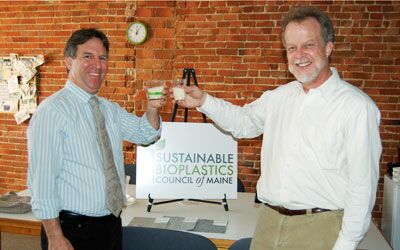Bioplastics cluster gets a toehold
 photo/Matt Dodge
Sustainable Bioplastics Council of Maine Project Manager Steve Taylor, left, and Vice President Mike Belliveau say a recently formed cluster is already helping the industry grow
photo/Matt Dodge
Sustainable Bioplastics Council of Maine Project Manager Steve Taylor, left, and Vice President Mike Belliveau say a recently formed cluster is already helping the industry grow
When a group of Maine manufacturers first met two years ago to discuss the emerging field of bioplastics, the conversation was abstract at best.
“That first conference was just like ‘What sort of research is going on at UMO, and wouldn't it be cool if we could do it',” says Trevor Maxwell, spokesman for the Sustainable Bioplastics Council of Maine, a trade association tasked with helping Maine businesses capitalize on the rapidly growing demand for bioplastics, or synthetics made from renewable biomass.
In a state with a strong agricultural and forest products legacy, the prospect of creating bioplastics and fuel from potatoes and wood chips was attractive. That interest, coupled with a growing demand to reduce dependence on petroleum and projections of 20% to 40% annual increases in bioplastics market demand, was too intriguing an opportunity to miss.
Two years after SBCOM's first meeting, Maine's bioplastics market has made some major strides in increasing visibility, securing funding and signing on influential industry partners like Tom's of Maine, True Textiles and the University of Maine. “It's now more of a defined, growing, active cluster. It's not just pie-in-the-sky anymore, we are actually making biomaterials and finished products,” says Maxwell.
This steady growth was evident two weeks ago in Boothbay when SBCOM hosted its annual conference at Biovation, a startup company in Boothbay producing non-woven fibers using polylactic acid derived from corn starch.
The conference brought companies from both ends of the value chain together to take stock of the current state of their industry and discuss strategies for moving forward in the $9.1 billion bio-based materials market. That market is expected to more than double to around $19.6 million by 2016, according to keynote speaker Andrew Soare of NYC-based Lux Research.
“I think a lot of smart companies realize that, especially in an emerging sector, collaboration and partnership is the way to go. It strengthens not only the cluster, but each individual partner,” says Steve Taylor, project manager for SBCOM.
In the past two years, SBCOM has grown from an informal collaboration between Maine's biomass producers and manufacturers to a nonprofit trade association, raising over $3 million and appointing a board of directors. “We help people become more aware of the resources available and how to tap into them,” says Mike Belliveau, vice president of SBCOM.
The University of Maine Forest Bioproducts Research Institute's impending Technology Research Center, a $4.8 million facility on the grounds of cluster partner Old Town Fuel & Fiber, is one example of the knowledge and technology exchange occurring between cluster members. “They will be able to do demonstration-scale projects using a whole variety of bio-based technologies for companies that want to scale up,” says Belliveau.
SBCOM was also able to contract a chemical engineer to help engineers at Rynell, a Wiscasset manufacturer of polyurethane prepolymers. Rynell has since spun off two companies, both bioplastics cluster members, in Biovation and South Portland's Grow-Tech. “It's that sharing of common knowledge and technology that has enabled companies to apply it to their specific purpose for their own development,” says Belliveau.
A combination of economic, corporate and environmental factors has driven the growth of the bioplastics market, according to Belliveau. Volatility in oil prices, increasing consumer awareness and “ambitious” sustainability goals from some of the country's largest companies have played a large part.
“When the big brands like Procter & Gamble or Coca-Cola set these goals, they have such a huge market pool that it drives everyone to increase production of bio-based materials to meet that demand,” he says.
Thanks to an abundance of forest products and agricultural waste, Maine is uniquely positioned to be a real player in the bioplastics market, according to Belliveau, especially since the fossil fuels and chemicals needed to raise a crop of corn make the vegetable an unsustainable alternative to petroleum-based plastics. “There are startups all around the world who are getting in on the bio-based materials revolution, and they are desperate for low-cost sugars as their basic building blocks. With wood sugars, we have the potential to produce lower-cost, high-quality sugars,” Belliveau says.
The purity of Maine's raw materials is a plus as well, according to Belliveau. “Maine biomass is not a genetically modified crop, and there are certain markets in Europe where you can't sell corn-based [bioplastics] because they won't buy GMOs, and over 80% of corn has GMOs. Also, some companies like Whole Foods won't touch GMO products, so that's another advantage Maine biomass has,” he says.
Janice Cormier with Guilford of Maine, formerly True Textiles, says the company has been using polylactic acid in some of their fabrics since 2006 — one of the first companies to embrace its use in fabric. At the conference, Cormier says she learned how any effort toward sustainable, greener business practices needs to be carefully studied from a consumer angle. She cites the example of the SunChips bag, a bioplastic-based, compostable bag that was yanked from shelves in less than a year after consumers complained about the loud crackling noise it produced.
Still, Cormier says she would opt for education over backpedaling when it comes to introducing bioplastics to the market. “There is definitely more education to do with consumers to let them know why they need this type of product. A lot of people might look at the new [bioplastic] Dasani bottle and think it's cute, but do they know why we have it?” she asks.









Comments